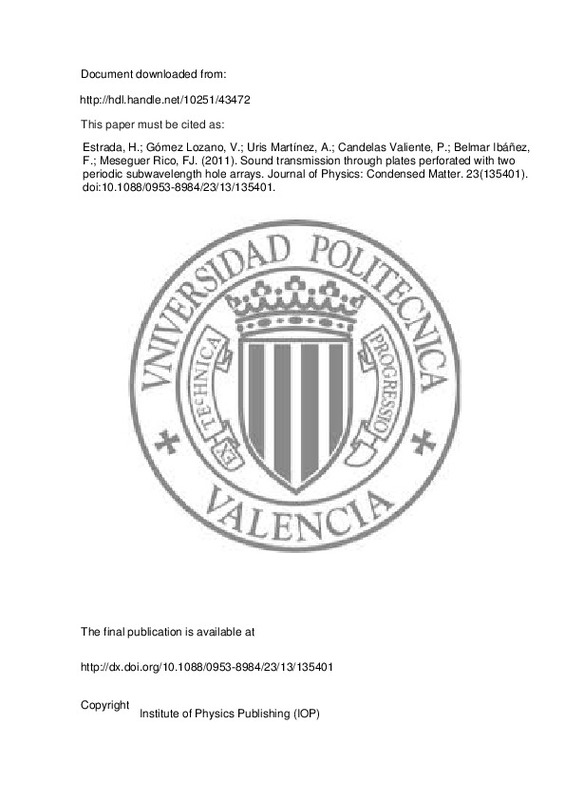JavaScript is disabled for your browser. Some features of this site may not work without it.
Buscar en RiuNet
Listar
Mi cuenta
Estadísticas
Ayuda RiuNet
Admin. UPV
Diseño de un Line Array y un Curved Array de bajo coste
Mostrar el registro sencillo del ítem
Ficheros en el ítem
| dc.contributor.advisor | Alba Fernández, Jesús
|
es_ES |
| dc.contributor.advisor | Bertó Carbó, Laura
|
es_ES |
| dc.contributor.author | Lorente Femenía, Juan Bosco
|
es_ES |
| dc.date.accessioned | 2014-02-17T10:41:19Z | |
| dc.date.available | 2014-02-17T10:41:19Z | |
| dc.date.created | 2013-09-03 | |
| dc.date.issued | 2014-02-17 | |
| dc.identifier.uri | http://hdl.handle.net/10251/35705 | |
| dc.description.abstract | Los line array son un grupo de elementos radiantes dispuestos de forma específica en línea recta, muy cercanos entre si y de forma vertical, operando en fase y con igual amplitud. Aunque el concepto de line array no es de reciente descubrimiento, sí que, en la última década, con la llegada del DSP y la disponibilidad de chips de coste aceptable, se ha encontrado una aplicación muy fructífera en el campo de la difusión del sonido. El objeto de este estudio es crear un prototipo de columna en array que cumpla un control de la cobertura vertical. Como punto de partida se ha analizado un sistema ya creado, del cual se intentará mejorar la parte acústica, es decir, lo que incumbe a los altavoces, caja acústica y filtrado. Bien es cierto que este tipo de columnas de altavoces son una solución muy eficiente y económica para sonorizaciones en ambientes acústicamente complicados, que requerirían grandes inversiones en acondicionamiento acústico. Es conocido en el sector de la electroacústica este dato y cada vez son más las empresas que presentan modelos de columnas de altavoces cada vez más dinámicas y ajustables por el montador o incluso el usuario. Con el diseño del prototipo se ha conseguido mejorar el control de la dispersión mediante filtrado pasivo, y se plantean futuras líneas de investigación basadas en la introducción de filtrado y retardo DSP para un mayor control del sonido con el objetivo de emitir solo en el área de audiencia. | es_ES |
| dc.description.abstract | The line array is a group of radiating elements arranged in a straight line specific, very close to each other and vertically, operating in phase and equal amplitude. Although the concept of line array is not newly discovered, it does, in the last decade with the advent of the DSP chip and the availability of acceptable cost has been found very successful application in the field of sound diffusion. The purpose of this study is to create a prototype array column that meets these needs of vertical coverage. As a starting point has been analyzed an already created, which will seek to improve the acoustics, what it is for speakers, speaker and filtering. It is true that this type of speaker columns are highly efficient and economical solution for acoustically complex environments that require large investments in acoustic conditioning. Is known in the field of electroacoustic this data and they are getting more companies present speaker column models increasingly dynamic and adjustable by the installer or the user. With the prototype design has been improved dispersion control by passive filtering, and proposes future research lines based on the introduction of DSP filtering and delay for a more sound control with the aim to issue only in the area of audience. | es_ES |
| dc.format.extent | 48 | es_ES |
| dc.language | Español | es_ES |
| dc.publisher | Universitat Politècnica de València | es_ES |
| dc.rights | Reserva de todos los derechos | es_ES |
| dc.subject | Line Array | es_ES |
| dc.subject | Directividad vertical | es_ES |
| dc.subject | Columna de altavoces | es_ES |
| dc.subject | Column array loudspeakers | es_ES |
| dc.subject | Ondas cilíndricas | es_ES |
| dc.subject | Curved Array | es_ES |
| dc.subject | Acoustically complex environments | es_ES |
| dc.subject | Low cost | es_ES |
| dc.subject | Bajo coste | es_ES |
| dc.subject.classification | FISICA APLICADA | es_ES |
| dc.subject.other | Máster Universitario en Ingeniería Acústica-Màster Universitari en Enginyeria Acústica | es_ES |
| dc.title | Diseño de un Line Array y un Curved Array de bajo coste | es_ES |
| dc.type | Tesis de máster | es_ES |
| dc.rights.accessRights | Cerrado | es_ES |
| dc.contributor.affiliation | Universitat Politècnica de València. Departamento de Física Aplicada - Departament de Física Aplicada | es_ES |
| dc.contributor.affiliation | Universitat Politècnica de València. Escuela Técnica Superior de Ingenieros de Telecomunicación - Escola Tècnica Superior d'Enginyers de Telecomunicació | es_ES |
| dc.contributor.affiliation | Universitat Politècnica de València. Departamento de Ingeniería Electrónica - Departament d'Enginyeria Electrònica | es_ES |
| dc.contributor.affiliation | Universitat Politècnica de València. Área de Posgrado - Àrea de Postgrau | es_ES |
| dc.contributor.affiliation | Universitat Politècnica de València. Escuela Politécnica Superior de Gandia - Escola Politècnica Superior de Gandia | es_ES |
| dc.contributor.affiliation | Universitat Politècnica de València. Centro de Tecnologías Físicas: Acústica, Materiales y Astrofísica - Centre de Tecnologies Físiques: Acústica, Materials i Astrofísica | es_ES |
| dc.description.bibliographicCitation | Lorente Femenía, JB. (2013). Diseño de un Line Array y un Curved Array de bajo coste. Universitat Politècnica de València. http://hdl.handle.net/10251/35705 | es_ES |
| dc.description.accrualMethod | Archivo delegado | es_ES |
Este ítem aparece en la(s) siguiente(s) colección(ones)
-
EPSG - Trabajos académicos [5004]
Escuela Politécnica Superior de Gandia




![[Cerrado]](/themes/UPV/images/candado.png)


